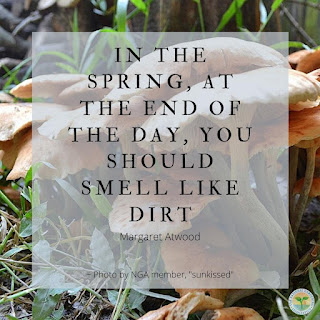 Greetings garden-friends, spring has sprung in the southern Willamette Valley where we live. Daffodils and crocuses are in full bloom. Many of the seedlings Chris planted directly in our greenhouse beds are doing well and Llyn has started the heat-loving seedlings in pots in our other greenhouse.
Greetings garden-friends, spring has sprung in the southern Willamette Valley where we live. Daffodils and crocuses are in full bloom. Many of the seedlings Chris planted directly in our greenhouse beds are doing well and Llyn has started the heat-loving seedlings in pots in our other greenhouse.
This post is comprised of a photo gallery of garden activities for February/March and relevant LINKS from previous posts we've written. Enjoy!
Bed-prep: We continue to prepare garden beds, both inside the greenhouses and out in the fields.
 |
Donn and Chris fluff our raised beds after adding worm compost (made right in the paths of our greenhouses - LINK), coffee grounds and wood-ash - LINK. The soil in these beds is amazingly rich and has great tilth!
|
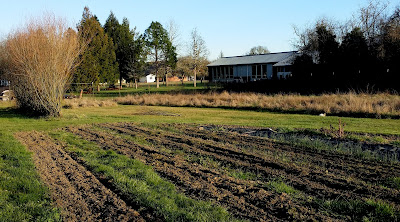 |
Here is one of our outside garden areas for heat-loving annual-plants (for example: squash, cabbage, broccoli, garlic, potatoes and more). We've been fortunate in that there have been long enough stretches between rain-storms for the soil to drain so we could roto-till these beds. This will make it easier to plant later in the spring and manage the weeds. That's a long row of basket-willow in the upper left corner of the picture.
|
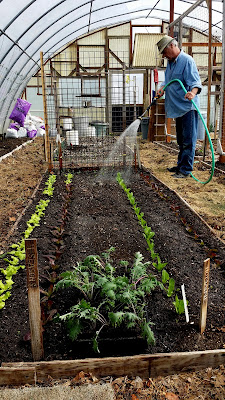 Starting seeds: February is time for starting seeds, directly in the ground in the raised beds in our greenhouses and in pots to be transplanted out later in the season. (Image right): Chris waters lettuce seedlings direct-seeded in
the ground. Kale plants in foreground are volunteers that sprouted over
winter. We have lots to share. Let us know if you want some.
Starting seeds: February is time for starting seeds, directly in the ground in the raised beds in our greenhouses and in pots to be transplanted out later in the season. (Image right): Chris waters lettuce seedlings direct-seeded in
the ground. Kale plants in foreground are volunteers that sprouted over
winter. We have lots to share. Let us know if you want some.
 |
Carrot seedlings started in early February. Pot of chives at top, right of picture.
|
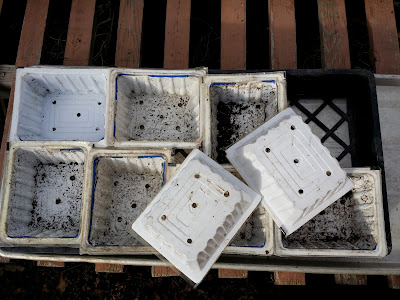 |
Some plants need to be started in pots on a heat-mat in order to germinate. We drill holes in the bottom of the plastic containers our tofu comes in and and start the seeds in them. Here's a LINK to a post about other ways to Repurpose Things for Re-use.
|
 |
Later, once the seeds have germinated, we'll transplant them into larger containers so they have enough soil to develop strong root-systems.
|
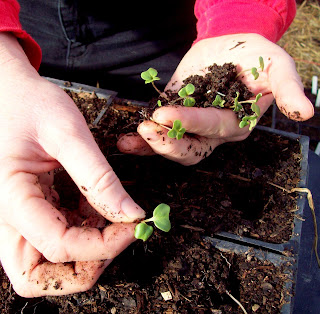 |
Transplanting seedlings takes patience but it's a lovely meditation too.
|
 |
Sometimes we transplant into standard plastic pots...(here are lettuce seedlings in 6-packs)...
|
 |
...but egg cartons make great containers for seedlings that don't have a big root system such a s lettuce. The seedlings' roots will grow right through the egg-cartons so all you have to do is tear off a section and plant it directly in the ground.
|
Planting perennials: If the ground isn't too wet or frozen, January through March are all good months to plant out perennial plants including trees, shrubs and flowers. In the winter, these plants are still be dormant in their pots (or bare-rooted if bought directly from a nursery). This year we have added three more apple trees, a quince and two varieties of plums to our orchards. We have an English walnut, several American chestnuts, a fig-tree and lots of yellow willow that we grew from seeds and cuttings that are ready to go in the ground. And, as for flowering perennials we're expanding our Showy milkweed and Echinacea plantings, also grown from seed.
 |
Llyn, planting trees.
|
 |
Our perennial plant nursery (summer). All these plants grown from seeds and cuttings benefit from a full year in pots to develop their root systems before being planted in the ground. Our nurseries receive plenty of indirect sunlight through the summer but don't like full sun as it can stress them in summer's heat.
|
 |
| In the winter we move perennial-pots into a sunny place protected from
the coldest north winds and surround the pots with bags of dry leaves
for insulation. |
 |
Our new orchard (foreground). We've had to convert some of our garden space into an orchard because we have an invasion of field bindweed/morning glory (Convolvulus arvensis LINK) which can choke many annual plants.
|
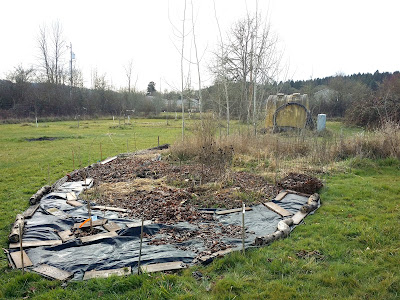 |
We are also creating areas dedicated primarily to wildlife habitat. The black plastic is lumber-wrap we collect for free from the garbage dumpsters at lumber-yards. It blocks sunlight to the plants below thus discouraging grasses and weeds from growing between the desirable perennial trees, shrubs and flowers and bulbs we've planted. It will be removed after one year and mulched heavily to slow down the inevitable re-invasion of grasses and weeds.
|
Pruning: Winter is pruning-time for our fruit and nut trees and grape vines.
 |
Chris, pruning grapes. For an excellent grape-pruning tutorial, see LINK below.
|
 |
| Llyn, pruning our 70' row of basket willow (Salix purpurea LINK). We harvest it every year to make living fences, to start more rows of willow along the edges of our land and occasionally to make baskets. |
 |
We're making a living fence (above) with basket willow to give us some privacy from our neighbor's yard. the uprights are actually rooted in the ground, planted approx. 8" apart and will live for many years. The horizontal "wattles" are cut fresh from our willow nursery (see above) and woven between the living uprights. They die and dry in place.
|
 |
Time to plant cuttings and seedlings of perennials into pots to grow out their roots for next year's plantings. Pictured: yellow willow that grows wild along stream beds in western Oregon, and Red Osier Dogwood ( Cornus sericea LINK) |
 |
All the prunings are piled in a large brush-pile where they dry out through the summer while providing habitat for ground-nesting birds and bunnies. In the autumn, once it's legal to burn again, and animals are no longer nesting, we'll set the pile on fire.
|
Repairs and organizing:
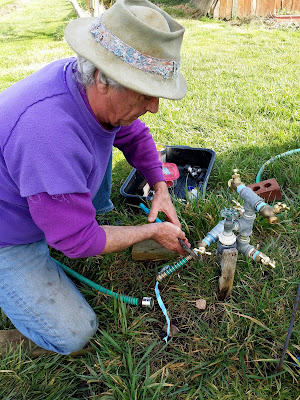 |
We finally got around to investing in, and installing brass hose-bibs for our garden faucets. These will last much longer than the plastic ones we had been using and prevent drips/leaks which waste water.
|
 |
We use the winter to reorganize both inside and outside areas of the gardens. These hose-hangers are made from foot-long shelf brackets screwed into the upright 4"x4' posts with 5-gallon buckets hung on them. We can put a lot more hoses on them and the buckets keep the hoses rounded instead of kinking into tight bends.
|
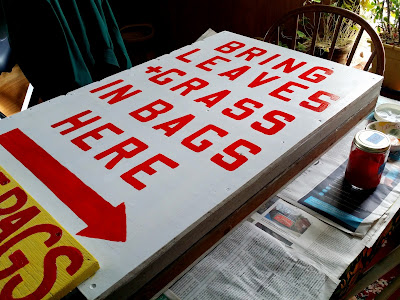 |
Time for repainting all our signs too...
|
LINKS for early spring: Here are links to posts we've previously written, relevant to this time of year.
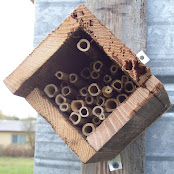 Early spring is time for Mason bees to emerge from their tube-nests. Here's an article written by a local friend of ours who's had great success at encouraging these docile pollinators to thrive on her land.
Early spring is time for Mason bees to emerge from their tube-nests. Here's an article written by a local friend of ours who's had great success at encouraging these docile pollinators to thrive on her land.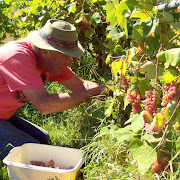
Here's the best video we've found on how to prune table grapes (and we've watched quite a few!). Easy, straight-forward instructions which will allow you to confidently go out to your grape patch and tackle the tangle of vines that have grown since last year (or the last time you attempted to prune your grapes).
On the lighter side... Here is a LINK to a video about Infectious Laughter on a Train




























No comments:
Post a Comment
Thank you for taking the time to leave a comment. We welcome your reflections and questions.